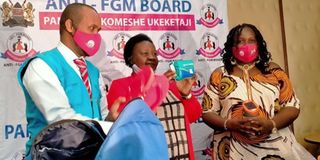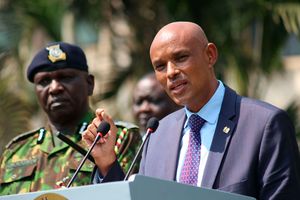Premium
Why Kikuyu will be the first community to end FGM in Kenya

From left Mr Haithar Ahmed Somo, Child Protection Specialist- Unicef Kenya, chairperson of Anti-FGM Board Agnes Pareyio and Ms Bernadette Loloju, CEO Anti-FGM Board. Mr Somo says ending poverty is pivotal to ending FGM.
What you need to know:
- Child Protection Specialist at Unicef Mr Haithar Ahmed says analysis by Unicef and Anti-FGM Board shows a general decline in FGM cases.
- In Wajir, Garissa, Tana River, Marsabit, Samburu, West Pokot, Kajiado, Kisii and Migori, FGM has increased by more than 100 per cent during the Covid-19 period.
- We need to change the mind-set of the boys to protect the girls; so that they can reject the tradition that only girls who are cut are marriageable.
Today, the world marks International Day of Zero Tolerance for Female Genital Mutilation (FGM) and as the fight to end the vice continues, major questions linger on. Are we cutting the numbers, traditions or minimising the dynamics?
Just how possible is it to have no girl or woman bleeding to death, suffering from indescribable pain when delivering because stitches have to be undone and done, or spending the rest of her life with fistula because her clitoris was partially or totally removed?
At the core of the journey towards zero FGM in Kenya and globally is United Nations International Children's Emergency Fund (Unicef), the entity whose statistics are used as a baseline for the prevalence rates.
Presently, it estimates that at least 200 million girls and women alive today and living in 31 countries, have undergone FGM. Together with United Nations Population Fund (UNFPA), they run a joint programme on the elimination of FGM.
The two entities and the Inter-African Committee on Traditional Practices (IAC) are the brains behind this year’s theme: No Time for Global Inaction, Unite, Fund, and Act to End Female Genital Mutilation.
Covid-19
Our reporter spoke to Child Protection Specialist at Unicef Mr Haithar Ahmed on the lights and darks in the journey.
Is FGM decreasing in Kenya?
In the context of Covid-19, it is increasing but that is an isolated scenario. In places where Unicef has worked like Wajir, Garissa, Tana River, Marsabit, Samburu, West Pokot, Kajiado, Kisii and Migori, FGM has increased by more than 100 per cent. Generally, however, it is decreasing for adolescent girls, nationally.
Data from Kenya Demographic and Health Survey (2014) shows a decline in numbers from 32 per cent in 2008/9 to 21 per cent in 2014. Further analysis by Unicef and Anti-FGM Board has also shown a decline. Three decades ago, one to 10 girls were cut against one to five at the moment
What anti-FGM strategies have worked?
Reduction of FGM is a collective contribution led by the government. It has the voice, resources, expertise on the ground and they can marshal the community to action. It also has the legitimacy to make laws. What has worked for us is the continuous partnership with Ministry of Public Service and Gender and the Anti-FGM Board.
Prohibition of Female Genital Mutilation Act (2011) and National Policy for the Eradication of FGM (2019) which was endorsed by the President Uhuru Kenyatta, are products of our collaboration. Now, under the joint program with UNFPA, we are developing contextualised county action plans and policies.
To what extent can policies contribute to ending FGM?
For FGM to end, it is just about policies. It takes engagement of a myriad of stakeholders; from the perpetrators to survivors, elders and medical practitioners. It is also important the discussions are held at the community level. For instance, we are doing community exchange programs and engaging youth clubs to create awareness.
The media too, plays a critical role in amplifying these voices from the government and community. This interplay of contribution defines the anti-FGM fight in Kenya.
How do we engage men in this course?
Let’s start with why do we need to engage men and boys? Men constitute 48 per cent of our population and they are the majority in leadership including in the church. Remember FGM, is done so that the girl is marriageable. A woman is considered a child because she is not cut and the men are the custodians of this culture.
We, however, need to map out the men who have the power in different sectors including politics, community and religious spectrum for stratified engagement. We also need to change the mind-set of the boys to protect the girls; so that they can reject the tradition that only girls who are cut are marriageable. And when they become husbands and fathers, they will for sure, protect their wives and daughters. This way, we will stop the continuous cycle of FGM.
Men can be engaged through community dialogues, giving the fathers an opportunity to support their daughters and appreciate the showcasing male champions who are firmly speaking against the vice. It is very important that the male champions are given Presidential Awards. A Presidential endorsement of their work as men fighting for rights of women and girls could go a long way in influencing change of attitude among other men in the Kenyan communities.
How does education lower girls’ risk to FGM?
The 2014 Kenya Demographic and Health Survey, shows educated women have not cut their daughters unlike the uneducated. That is why Kikuyu is the only community among the 35 communities that practice FGM in Kenya, projected to end FGM by 2030. This is based on Unicef’s and anti-FGM Board projections. And education is the contributing factor. Illiteracy levels in Mt Kenya region are low compared to other parts of the country. It is through education that they know harmful effects of FGM and that it violates their rights, therefore, they don’t do it.
Create a picture of the long-term effects of FGM on girls
FGM is interconnected to teenage pregnancies that lead to loss of an education and income. Eventually, it reduces the contribution of girls to national development. An education gives a girl the power to be economically empowered and have the voice to defy the tradition. And when they become wives, they are able to stand up for their daughters when their husbands demand of them to be cut because they are economically independent.
Can we end FGM without ending poverty?
We have seen fathers abandon their families because their wives could not allow their daughters to be cut. In these cases, they are the breadwinners. How will a woman say no if she is not empowered, if she cannot feed her children?
Again, girls are seen to be of economic value. In most communities including Maasai, Samburu and Rendille, behind FGM there is a child marriage. For the family to get three or four cows, the girl has to be prepared for the marriage. Then they use the cows to pay for her brother’s dowry. So ending poverty is pivotal to ending FGM.





